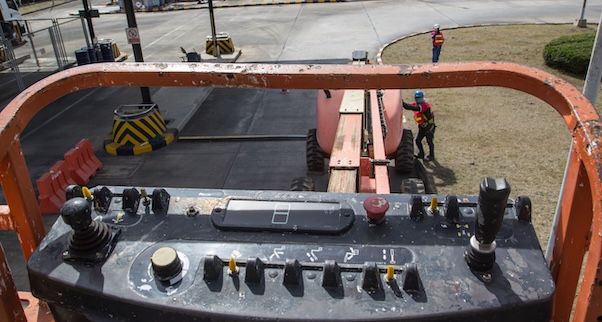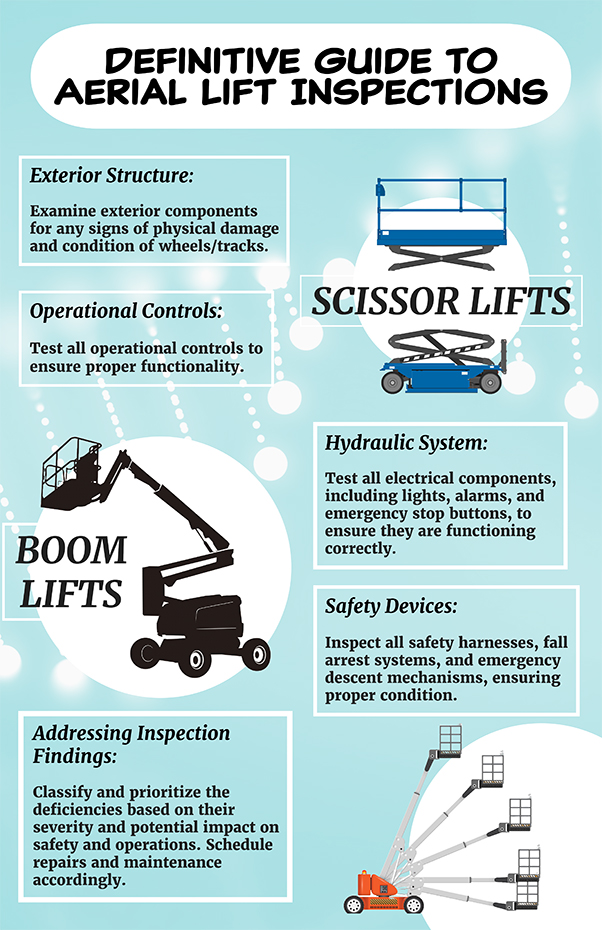
The Definitive Guide to Aerial Lift Inspection
As construction and maintenance projects continue to grow in complexity and scale, the use of aerial lifts has become increasingly common. These versatile machines allow workers to access elevated areas safely and efficiently. However, to ensure smooth operations and promote safety, it is crucial to perform regular inspections on all aerial lifts. In this comprehensive guide to aerial lift inspections, we will delve into the importance of aerial lift inspections and provide you with a step-by-step process to carry out effective inspections.
Aerial lifts, also known as boom lifts or cherry pickers, are valuable assets in many industries, including construction, maintenance, and utilities. These machines enable workers to perform tasks at elevated heights with enhanced safety and efficiency. However, like any equipment, aerial lifts require regular inspections to ensure they are in optimal working condition.
Understanding Aerial Lift Inspections
Why Are Aerial Lift Inspections Necessary?
Aerial lift inspections are crucial for several reasons. First and foremost, they help identify any potential issues or malfunctions that could compromise the safety of operators and other personnel working nearby. Regular inspections also contribute to compliance with safety regulations and standards set by governing bodies.
Compliance with Safety Standards
Regulatory bodies, such as the Occupational Safety and Health Administration (OSHA), require employers to maintain a safe working environment for their employees. Creating a site safety plan with a guide to aerial lift inspection plays a vital role in ensuring compliance with these safety standards, as they help identify and rectify any safety hazards associated with the equipment.
Identifying Potential Hazards
By conducting thorough inspections, operators and inspectors can identify potential hazards, such as hydraulic leaks, worn-out safety harnesses, faulty electrical systems, or structural issues. Identifying these hazards early on allows for prompt repairs, reducing the risk of accidents or equipment failures during operations.
Preparing for an Aerial Lift Inspection
Creating a Guide to Aerial Lift Inspection
Before conducting an aerial lift inspection, it is essential to create a guide to aerial lift inspection which is essentially a checklist. This checklist serves as a guide to ensure that all critical components and systems of the aerial lift are thoroughly examined. It should include items such as the condition of the platform, the functionality of the controls, the integrity of safety devices, and the overall structural stability of the lift.

Gathering the Required Tools and Equipment
To perform an aerial lift inspection effectively, you'll need specific tools and equipment. These may include a flashlight, a multimeter for electrical system testing, a pressure gauge for hydraulic system evaluation, and a tape measure for assessing structural dimensions. Ensure that you have all the necessary tools readily available before beginning the inspection process.
Conducting an Aerial Lift Inspection
Aerial lift inspections should be carried out systematically, covering various aspects of the equipment. Here is a step-by-step guide to aerial lift inspection process.
Exterior Inspection
Start by visually examining the exterior components of the aerial lift. Check for any signs of physical damage, such as dents, cracks, or corrosion. Inspect the tires or tracks for wear and proper inflation. Pay close attention to the condition of the guardrails, gates, and access ladders.
Hydraulic System Inspection
Evaluate the hydraulic system, which powers the lift's movements. Inspect hydraulic hoses for leaks, bulges, or abrasions. Check hydraulic fluid levels and ensure they are within the manufacturer's recommended range. Test the lift's raising and lowering capabilities to verify smooth operation.
Electrical System Inspection
Thoroughly examine the electrical system of the aerial lift. Inspect wiring connections for any signs of fraying or damage. Test all electrical components, including lights, alarms, and emergency stop buttons, to ensure they are functioning correctly. Use a multimeter to check voltage levels and troubleshoot any electrical issues.
Operational Controls Inspection
Test all operational controls to ensure proper functionality. Check the control panel for worn-out buttons or switches. Activate each control to verify that it corresponds to the intended lift movement. Pay attention to the response time and smoothness of the controls during operation.
Safety Devices Inspection
Inspect all safety devices installed on the aerial lift. This includes safety harnesses, fall arrest systems, and emergency descent mechanisms. Ensure that all safety devices are in good condition, properly secured, and free from defects. Test the emergency descent mechanism to ensure it operates smoothly.
Structural Inspection
Evaluate the overall structural integrity of the aerial lift. Inspect the platform, boom, and stabilizing outriggers (if applicable) for any signs of cracks, bent components, or excessive wear. Measure critical dimensions to ensure they align with the manufacturer's specifications. Structural issues can compromise the safety and stability of the lift and should be addressed promptly.
Addressing Inspection Findings
Once your checklist (guide to aerial lift inspection) is complete, it's important to address any findings or deficiencies identified during the process. Classify and prioritize the deficiencies based on their severity and potential impact on safety and operations. Schedule repairs and maintenance accordingly, ensuring that qualified technicians handle complex issues.
Training and Certification for Inspectors
To follow your guide to aerial lift inspection effectively, inspectors should receive proper training and certification. Training programs cover topics such as equipment operation, inspection techniques, safety protocols, and relevant regulations. Staying up to date on industry advancements and changes in safety standards is crucial to maintain inspector competence.
Maintaining Inspection Records
Maintaining detailed records of aerial lift inspections is essential for regulatory compliance and accountability. Documentation should include inspection dates, findings, repairs conducted, and follow-up actions taken. Organize these records systematically and keep them readily accessible for future reference.
Get overhead crane operator training to open up a world of possibilities. All Purpose Crane Training offers industry-recognized training to help you advance in your career.
Common Challenges in Aerial Lift Inspections
Aerial lift inspections come with their fair share of challenges. It's important to be aware of these challenges and be prepared to address them effectively. Here are two common challenges and ways to overcome them:
Overcoming Heightened Safety Risks
Conducting inspections at elevated heights introduces additional safety risks for inspectors. To overcome this challenge, ensure that inspectors are equipped with appropriate personal protective equipment (PPE) such as hard hats, safety harnesses, and non-slip footwear. Inside your site safety plan, which should include the guide to aerial lift inspection checklist, implement strict safety protocols, including the use of fall protection systems and proper training on working at heights. Regularly assess the condition of ladders, stairs, and access points to ensure safe entry and exit from the aerial lift.
Dealing with Weather Conditions
Weather conditions can significantly impact the inspection process, particularly for outdoor aerial lifts. Adverse weather, such as strong winds, heavy rain, or snow, can make inspections unsafe or affect the accuracy of the assessment. Monitor weather forecasts and reschedule inspections if conditions pose a risk to personnel or compromise the thoroughness of the inspection. If inspections must be conducted in inclement weather, take additional precautions such as securing the aerial lift and using appropriate barriers or covers to protect equipment and inspectors.
Regular and thorough aerial lift inspections are crucial for ensuring the safe and efficient operation of these valuable machines. By following the guide to aerial lift inspection process, addressing identified deficiencies promptly, and maintaining accurate inspection records, you can create a culture of safety and compliance within your organization. Remember, the well-being of your workers and the success of your projects depend on the reliability and functionality of your aerial lifts.
Unlocking Success: Take your career to new heights with our mobile crane operator training. Enhance your skills in operating various types of mobile cranes, master rigging techniques, and ensure safety on job sites.
FAQs (Frequently Asked Questions)
Why are aerial lift inspections & site safety plans necessary?
Site safety plans, which can include the guide to aerial lift inspection, are necessary to ensure the safety of operators and personnel working nearby, to identify potential hazards or malfunctions, instruct on emergency safety protocols and to comply with safety standards & regulations.
How often should aerial lifts be inspected?
Inside of your guide to aerial lift inspection, the frequency of said aerial lift inspections depends on various factors, including usage, environment, and manufacturer recommendations. Regular inspections, at least annually or as specified by regulations, are generally recommended.
Who should conduct aerial lift inspections?
Trained and qualified operators and inspectors who have a thorough understanding of the equipment, the guide to aerial lift inspection and safety regulations and protocols, are generally recommended to conduct aerial lift inspections.
Can operators perform aerial lift inspections?
While operators can conduct visual inspections before each use, thorough inspections require specialized knowledge and expertise. Inspections should be carried out by dedicated inspectors or trained maintenance personnel.
What should I do if I find deficiencies during an inspection?
If deficiencies are identified during an inspection, they should be classified based on their severity and addressed promptly. Schedule repairs and maintenance to ensure the safe operation of the aerial lift.
In conclusion, this definitive guide to aerial lift inspection has provided you with comprehensive insights into aerial lift inspections. By following the outlined steps and best practices, you can ensure smooth operations, promote safety, and maintain compliance with industry regulations. Regular inspections and timely maintenance will not only protect your workers but also enhance the efficiency and longevity of your aerial lift equipment.